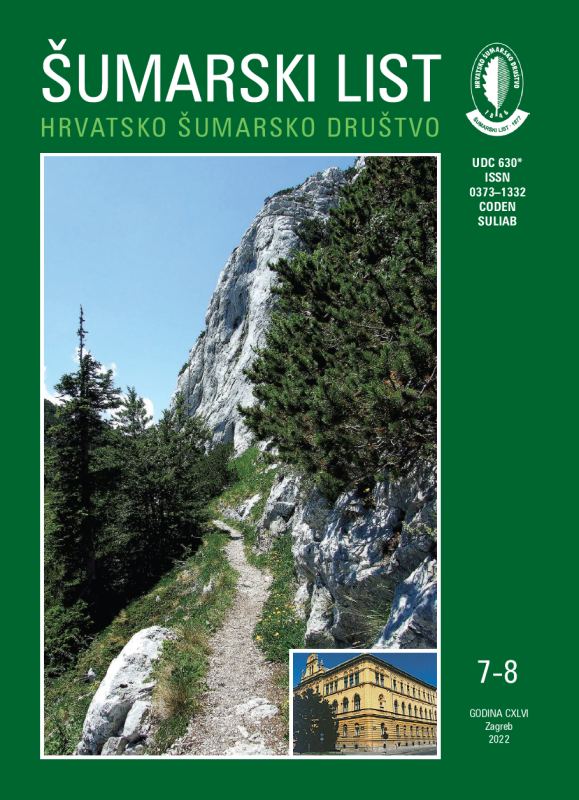
broj: 7-8/2022
pdf (12,97 MB) |
|
||||||||||||||
| RIJEČ UREDNIŠTVA | ||
| Uredništvo | ||
| Why do we lag behind in the green transition and energy independence? pdf HR EN | 281 | |
| IZVORNI ZNANSTVENI ČLANCI | ||
| Damir Ugarković, Ivica Tikvić, Ivana Grgurić, Ivan Perković, Nataša Hulak, Vibor Roje, Petar Šutalo, Krešimir Popić | UDK 630* 114.7 (001) https://doi.org/10.31298/sl.146.7-8.1 | |
| Enzymatic activity of forest soil in damaged forest ecosystem of silver fir with hard fern pdf HR EN | 283 | |
| Krunoslav Sever, Antonia Vukmirović, Luka Hodak, Saša Bogdan, Ida Katičić Bogdan, Daniel Krstonošić, Tomislav Karažija, Jozo Franjić, Željko Škvorc | UDK 630*231 + 233 (001) https://doi.org/10.31298/sl.146.7-8.2 | |
| Functional adaptation of natural sessile oak and common beech saplings on different habitat conditions pdf HR EN | 293 | |
| Vladan Popović, Darka Šešlija Jovanović, Aleksandar Lučić, Ljubinko Rakonjac, Sanja Jovanović, Aleksandar Vasiljević, Danijela Miljković | UDK 630* 164 (001) https://doi.org/10.31298/sl.146.7-8.3 | |
| Spatial variation of morphological needle traits of silver fir (Abies alba Mill.) populations in the Balkan peninsula in relation to climatic factors pdf HR EN | 309 | |
| Vojislav Dukić, Miroslav Mirković, Branko Stajić, Danijela Petrović, Marko Kazimirović, Srđan Bilić | UDK 630* 111.8 (001) https://doi.org/10.31298/sl.146.7-8.4 | |
| Comparative analysis of the influence of climate factors on the radial growth of autochthonous pine species (Pinus spp.) in central Bosnia and Herzegovina pdf HR EN | 319 | |
| Abdullah E. Akay, H. Hulusi Acar, Buse Kalkan | UDK 630*907.1 (001) https://doi.org/10.31298/sl.146.7-8.5 | |
| Using GIS techniques for modeling of anthropogenic noise propagation generated by a chainsaw in forest harvesting pdf HR EN | 333 | |
| Alptug Sari | UDK 630*156 (001) https://doi.org/10.31298/sl.146.7-8.6 | |
| Maximum Entropy Niche-Based Predicting of Potential Habitat for the Anatolian Leopard (Panthera pardus tulliana Valenciennes, 1856) in Türkiye pdf HR EN | 345 | |
| Summary The Anatolian leopard (Panthera pardus tulliana Valenciennes, 1856) is the largest surviving cat species in Türkiye. Despite the adversity they face, leopards still exist in Türkiye. In this study, using the maximum entropy model (MaxEnt), potentially suitable habitats for the Anatolian leopard in Türkiye was surveyed. When evaluating leopard habitat preference, the fact that the species can easily adapt to its habitat and live anywhere with sufficient vegetation and sufficient prey animals was taken into account; only data on climate which affects the geographic distribution patterns and population structures of flora and fauna were examined before. When the climatic variables affecting leopard’ distribution were examined, the following had the highest values: isothermally, seasonal temperature, average temperature of the coldest season, minimum temperature of the coldest month, and annual precipitation. Except for the Central Anatolia Region and coastal areas, almost every region in Türkiye contains habitats suitable for the leopard. There are scarce data on leopards’ populations and habitats in Türkiye. Therefore, even though ecological niche modelling (ENM) may generate important results when determining potentially suitable habitats, it is clear that this model cannot yield accurate results without considering the areas that the species is known to inhabit but in which no studies were previously conducted. The results that were obtained in the present study can also provide background information related to the long-term conservation of this species. Key words: Bioclimatic data; Conservation; Habitat suitability; Leopard; MaxEnt; Türkiye | ||


